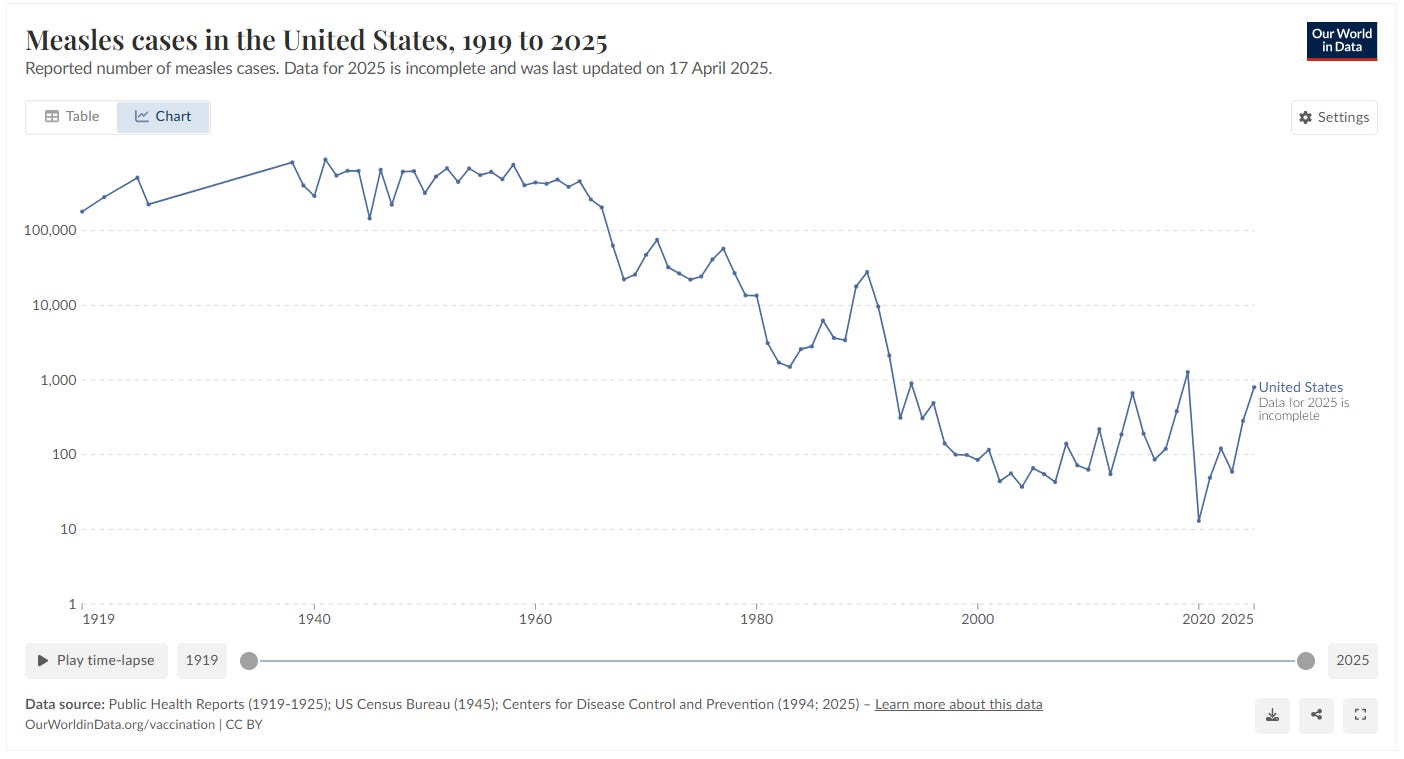If you’re of a certain age, you know measles. If you’re my age or older, you likely had measles, German measles (rubella), chicken pox, and mumps. Less common were diphtheria and whooping cough (pertussis), but not unknown.
I’m curious:
I had measles as a kid, and I’m pretty sure everyone with whom I grew up had it too. Most of the kids I grew up with were lucky, didn’t die, and didn’t end up with serious aftereffects. Here are some data points: Source.
Notice the drop in the early 60’s when the first vaccines became available, and a downward trend. Until now.
But before the early 1960’s more than 100,000 people contracted measles annually in the US.
YIKES!
Researchers from Stanford, Baylor, Rice and Texas A&M did some research and some modeling, and it was published in JAMA. Link. They looked not only at measles (one of the most contagious diseases the world has ever known) but other vaccine-preventable diseases, and concluded:
At current state-level vaccination rates, measles may become endemic again; increasing vaccine coverage would prevent this. Under a 50% decline in childhood vaccination in the US, the simulation model predicted 51.2 million measles cases over a 25-year period, 9.9 million rubella cases, 4.3 million poliomyelitis cases, 197 diphtheria cases, 10.3 million hospitalizations, and 159 200 deaths.
Based on estimates from this modeling study, declining childhood vaccination rates will increase the frequency and size of outbreaks of previously eliminated vaccine-preventable infections, eventually leading to their return to endemic levels. The timing and critical threshold for returning to endemicity will differ substantially by disease, with measles likely to be the first to return to endemic levels and may occur even under current vaccination levels without improved vaccine coverage and public health response. These findings support the need to continue routine childhood vaccination at high coverage to prevent resurgence of vaccine-preventable infectious diseases in the US.
BUT
Over a 25-year period and under a scenario with current state-level vaccination rates, the simulation model predicted there would be 851 300 cases (95% UI, 381 300-1.3 million cases) of measles, 190 cases (95% UI, 154-230 cases) of rubella, 18 cases (95% UI, 3-61 cases) of poliomyelitis, and 8 cases (95% UI, 1-22 cases) of diphtheria.
I know that there are lots of morons out there. I do NOT understand why a parent wouldn’t vaccinate their kids when the data indicates that under current vaccination levels, there would be about a million cases over 25 years, compared to over 50 million cases if vaccination rates decline. Okay, they probably don’t understand the math that “no vaccination” leads to a greater number of aggregate cases and thus a higher probability of their children becoming infected.
But here’s my question. And I’m going to put it in as “politically correct” a way as I can. KFF recently polled on measles, and associated false claims, such as that the MMR vaccine causes autism, that vaccines are more dangerous than the disease, and that Vitamin A can prevent measles.
When you look at all their charts, what you end up seeing is that partisanship has a lot of bearing on whether someone BELIEVES the false claims, and impacts whether folks get their kids vaccinated.
So here’s the question: are these people just plain stupid, or is there some other reason that they fall for falsehoods?
You may wonder why I bring this up. It’s because this is what’s coming our way. It won’t just be measles, but other known and novel diseases. We have zero governmental protection, and so it pays to pay attention to what is happening in your local geography. For now, local Boards of Health and Health Departments are still disseminating information, and that’s helpful.
It pays to stock your house now with products that could get much more expensive in the coming months: PPE, cleaning/disinfecting supplies, OTC meds. Just in case. I’m not a prepper, and don’t think it pays to have a Quonset hut of supplies, but just like always having a first aid kit, it pays to be prepared. And no, I don’t think we’re going to see a summer of spreading illnesses, but I’m concerned about next winter.






Just got my blood work back and my doctor recommended an MMR shot.
I remember having measles as a kid but my bloodwork showed I do not have immunity.
I was born in May of ‘56!
Having worked with a cohort of families impacted by the pre-MMR 1960’s rubella epidemic that caused blindness, deafness, and cognitive disability in kids whose moms had rubella while pregnant, I think there needs to be much more messaging about this risk. Measles is thought of as familiar mostly not dangerous while the risk to fetuses would be terrifying if only people knew about it.